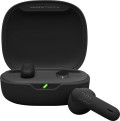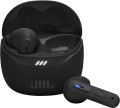Impedance
Impedance refers to the headphone's nominal resistance to AC current, such as an audio signal.
Other things being equal, a higher impedance reduces distortion, but requires a more powerful amplifier — otherwise the headphones simply will not be able to produce sufficient volume. Thus, the choice of resistance depends primarily on which signal source you plan to connect the "ears". So, for a portable gadget (smartphone, pocket player), an indicator of
16 ohms or less is considered optimal,
17 – 32 ohms is not bad. Higher values —
33 – 64 ohms and
65 – 96 ohms — will require quite powerful amplifiers, like those used in computers and televisions. And models with a resistance of
96 – 250 ohms and
above are designed mainly for Hi-End audio equipment and professional use; for such cases, detailed recommendations for selection can be found in special sources.
Noise cancellation
A system that reduces the influence of ambient noise on the audibility of sound through headphones. "Noise reduction" with the help of a separate microphone (or several micro) "listens" to external sounds and sends the same sounds to the headphones, but in antiphase. Due to this, the noise heard by the ears is attenuated almost to zero and the user can enjoy the sound of the headphones without interference even in a rather “loud” environment. For filtering in headphones, Active Noise Cancellation (ANC) and Environment Noise Cancellation (ENC) systems are used. The first suppresses all the noise around the listener, the second - reduces the noise level of the environment.
Active noise cancellation affects the purity of the sound, but the noise from the outside spoils the picture when listening to audio tracks even more.
Also in the headphones there is an adaptive active noise reduction system Adaptive ANC, aimed at automatically adjusting the sound of the headphones depending on the level of ambient noise. In a noisy environment (for example, when traveling on the subway), the Adaptive ANC system enhances the work of “noise reduction”, in the absence of loud sounds from outside, it weakens the noise reduction.
Voice assistant
Headphones with voice assistant support the user interaction with the device to a new level. The call of the
assistant. is carried out by pressing one of the control buttons on the headphones or by a specific voice command (for example, «Ok, Google» for the Google Assistant virtual apprentice). The assistant pauses playback, instantly changes the volume of the music, can notify the user of new alerts, helps to answer messages without the help of hands, and commands are given to the paired smartphone via voice control from the headphones.
Headphone battery capacity
The capacity of the battery installed in the headphones of the corresponding design (see "Power").
Theoretically, a higher capacity allows to achieve greater battery life, but in fact, the operating time also depends on the power consumption of the headphones — and it can be very different, depending on the characteristics and design features. So this parameter is secondary, and when choosing it is worth paying attention not so much to the battery capacity, but to the directly claimed operating time (see below).
Case battery capacity
The capacity of the battery installed in the case (case) for headphones.
This parameter is relevant only for true wireless models (see "Cable type"). Recall that these headphones are charged from a case, which is usually equipped with its own battery and actually works in standalone power bank mode. Knowing the capacity of the battery in the case and in the headphones, you can estimate how many charges of the “ears” will last for one charge of the case. However, it should be taken into account that in the process of charging the headphones, part of the energy is inevitably spent on third-party losses, and the effective capacity of the case turns out to be somewhere 1.6 times less than the claimed one. This is the starting point for calculations: for example, a 300 mAh case will actually be able to transfer 300 / 1.6 = 187 mAh of energy to the headphones, and 30 mAh “ears” from such a battery can be fully charged about 6 times (187 / 30 ≈ 6).
Operating time (music)
The declared operating time of headphones with autonomous power supply (see above) when listening to music on a single battery charge or a set of batteries.
As a rule, the characteristics indicate a certain average operating time in music listening mode, for standard conditions; in practice, it will depend on the intensity of use, volume level and other operating parameters, and in models with replaceable batteries - also on the quality of specific batteries. However, based on the stated time, you can fairly reliably assess the autonomy of the selected headphones and compare them with other models. As for specific values, relatively “short-lived” devices have a battery life
of up to 8 hours, a figure of
8 – 12 hours can be called quite good,
12 – 20 hours – very good, and in the most “long-lasting” headphones the operating time can
exceed 20 hours.
Operating time (talk)
The maximum battery life of headphones on one full charge of the battery or replaceable batteries in talk mode. A long working time will be relevant for those who expect to regularly conduct long telephone conversations. Note that in talk mode, autonomy may be lower than when listening to music, since the use of microphones and clear voice transmission algorithms puts an additional burden on the hardware of the headphones.
Operating time (no noise canceling)
How long does the active noise canceling headphones (see above) last on a single battery charge (or a set of batteries) when noise canceling is not used.
This function is quite “gluttonous” in terms of battery consumption, up to half of the total energy consumed by the headphones can go to its work. Thus, models with noise reduction can indicate both overall battery life (see "Operating time"), and battery life with the noise reduction turned off.
Operating time (with case)
The maximum operating time of TWS headphones, taking into account recharging with a native case. But this time is not continuous use, it takes into account breaks for "refueling". Anyway, this parameter allows you to understand for how long you can leave the network (for example, how many nights to spend in a tent to the accompaniment of your favorite artist).

